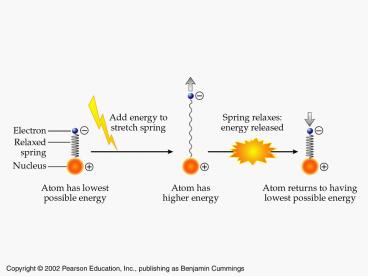Energy Level Diagram - PowerPoint PPT Presentation
1 / 64
Title: Energy Level Diagram
1
(No Transcript)
2
(No Transcript)
3
(No Transcript)
4
Energy Level Diagram
- Energy
- Excited States
- photons path
- Ground State
Light Emission Light Emission
Light Emission
5
Quantum Numbers - I
- 1) Principal Quantum Number n
- Also called the energy quantum number,
indicates the approximate distance from the
nucleus . - Denotes the electron energy shells around the
atom, and is derived directly from the
Schrodinger equation. - The higher the value of n , the greater the
energy of the orbital, and hence the energy of
electrons in that orbital. - Positive integer values of n 1 , 2 , 3 , etc.
6
(No Transcript)
7
(No Transcript)
8
(No Transcript)
9
Energy-level diagram for the electron in the
hydrogen atom.
10
Transitions of the electron in the hydrogen atom.
11
(No Transcript)
12
(No Transcript)
13
Using the Rydberg Equation
Problem Find the energy change when an electron
changes from the n4 level to the n2 level in
the hydrogen atom? What is the wavelength of this
photon? Plan Use the Rydberg equation to
calculate the energy change, then calculate the
wavelength using the relationship of the speed of
light. Solution
Ephoton -2.18 x10 -18J -
Ephoton -2.18 x 10 -18J -
- 4.09 x 10 -19J
h x c E
(6.626 x 10 -34Js)( 3.00 x 108 m/s)
wavelength
4.09 x 10 -19J
wavelength 4.87 x 10 -7 m 487 nm
14
Back to Ch 3
15
Modern Reassessment of the Atomic Theory
1. All matter is composed of atoms. Although
atoms are composed of smaller particles
(electrons, protons, and neutrons), the atom
is the smallest body that retains the unique
identity of the element. 2. Atoms of one element
cannot be converted into atoms of another
element in a chemical reaction. Elements can only
be converted into other elements in Nuclear
reactions in which protons are changed. 3. All
atoms of an element have the same number of
protons and electrons, which determines the
chemical behavior of the element. Isotopes
of an element differ in the number of neutrons,
and thus in mass number, but a sample of the
element is treated as though its atoms have
an average mass. 4. Compounds are formed by the
chemical combination of two or more elements
in specific ratios, as originally stated by
Dalton.
16
(No Transcript)
17
(No Transcript)
18
(No Transcript)
19
(No Transcript)
20
(No Transcript)
21
(No Transcript)
22
(No Transcript)
23
(No Transcript)
24
Predicted Properties Observed
properties (average of Si and Sn) Ge Atomic
mass 72 72.61 Density 5.5 g/cm3 5.32
g/cm3 Melting Point 82.5?C 93.8?C Oxide
formula XO2 GeO2 Density of oxide 4.7
g/cm3 4.70 g/cm3 Chloride formula XCl4 GeCl
4 Boiling point of chloride 100?C 86?C
25
Orbital energies of the hydrogen atom.
26
(No Transcript)
27
(No Transcript)
28
(No Transcript)
29
(No Transcript)
30
(No Transcript)
31
(No Transcript)
32
(No Transcript)
33
(No Transcript)
34
(No Transcript)
35
(No Transcript)
36
(No Transcript)
37
Electron Configurations Noble Gases
Electron Orbitals
Number of Electrons Element
1s2
2
He
1s2 2s22p6
10
Ne
1s2 2s22p6 3s23p6
18 Ar
1s2 2s22p6 3s23p6 4s23d104p6
36 Kr
1s2 2s22p6 3s23p6 4s23d104p6 5s24d105p6
54 Xe
1s2 2s22p6 3s23p6 4s23d104p6 5s24d105p6
6s24f14 5d106p6 86 Rn
1s2 2s22p6 3s23p6 4s23d104p6 5s24d105p6
6s24f145d106p6 7s25f146d10?
38
Figure 8.12 A periodic table illustrating the
building-up order.
39
(No Transcript)
40
Heisenberg Uncertainty Principle
- It is impossible to know simultaneously both the
position and momentum (mass X velocity) and the
position of a particle with certainty !
41
(No Transcript)
42
(No Transcript)
43
(No Transcript)
44
(No Transcript)
45
(No Transcript)
46
(No Transcript)
47
(No Transcript)
48
(No Transcript)
49
(No Transcript)
50
(No Transcript)
51
(No Transcript)
52
(No Transcript)
53
(No Transcript)
54
(No Transcript)
55
(No Transcript)
56
(No Transcript)
57
Cutaway diagrams showing the spherical shape of S
orbitals.
58
(No Transcript)
59
(No Transcript)
60
The 2p orbitals.
61
Radial probability Accurate
Stylized Combined
area distribution
representation of the 2p
of the three 2p
of the 2p
distribution orbitals 2px,
2py
distribution
and 2pz orbitals
62
(No Transcript)
63
The five 3d orbitals.
64
(No Transcript)





















![Energy is FREE - Like the AIR that you breathe [File 2 (or 1) of 5] PowerPoint PPT Presentation](https://s3.amazonaws.com/images.powershow.com/9270442.th0.jpg?_=20190520017)








